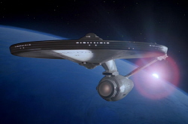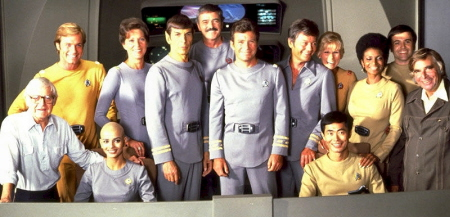December 7, 1979 was a momentous day for Trekkers the world over, for it was on this day that the long, “Great Trek Drought” of the 1970s came to an end with the theatrical release of Star Trek: The Motion Picture.
During the decade which had elapsed since the broadcast of the original Star Trek series’ last episode, fans had been given precious little to satisfy their appetites for new adventures with Captain Kirk and the crew of the U.S.S. Enterprise. A Saturday-morning cartoon series from 1973 to 1974 with the original cast giving voice to their animated doppelgangers helped ease the pain a bit, as did a handful of novels, comic books, games, action figures, and other merchandise. Then, in the mid-1970s, Paramount Pictures announced its plans to create a fourth television network, with “Star Trek: Phase II” as one of its flagship programs. The new series would have brought back everyone from the original show with the exception of Leonard Nimoy.
With Star Wars raking in piles of cash during the summer (and fall…and winter…etc.) of 1977, Hollywood studios were scrambling to greenlight anything which might tap into that success. Paramount saw its own stars to be found on the silver screen, and plans for a full-fledged big-budget Star Trek movie were put into motion.
So, Star Trek: The Motion Picture.
It’s interesting to note the movie’s rather rocky production history. By the time the decision was made to scrap the “Phase II” plans and proceed with a feature film, the in-development series had already incurred some rather sizable expenses. Sets had been built, costumes created, even a shooting model for the “new” Enterprise was under construction. Add in the fees to writers for stories and scripts and the plethora of other up-front costs for developing a new television series, and the tally was beginning to look like real money…or, at least whatever “real money” looks like to Hollywood executives.
All of those expenditures eventually were rolled into the budget for Star Trek: The Motion Picture even as sets were either massively rebuilt or constructed from scratch, new costumes and uniforms were designed, and new filming models and special effects were commissioned. By the time the film gestated from concept to finished product on the screen, it had accumulated a production budget in excess of $45 million—big, big money for 1979. Piling onto all of this was a studio-mandated immovable release date and a filming schedule interrupted with script rewrites on an almost-daily basis. Given such circumstances, one might start to think they had the makings of an utter catastrophe unfolding before their very eyes.
Of course, back then—in the days before internet message boards and genre news websites—none but the most die hard fans and followers of the screen industry possessed any knowledge of the troubles plaguing the film’s production. All they knew was that a big, lavish, expensive Star Trek movie was coming to their local theaters, and when that fateful Friday in December 1979 finally arrived, the response was decidedly mixed.
Many of the complaints are as old as the film itself:
- It’s too long.
- It’s too slow.
- It’s too blah-looking.
- But, hey! The music rocks.
Director Robert Wise had for many years and with great humility taken most of the heat for the film’s length and pacing, admitting that he would have made it tighter if he’d only had more post-production time. That lack of time resulted in a film containing—among other things—incomplete special effects sequences and a deficient sound mix. Some of this was addressed in a longer cut of the movie created for its television broadcasts (and later released on home video), but these “enhancements” really serve only to highlight and even expand upon the existing flaws.
 As for the movie’s look, it was Wise’s intention to lend an air of sophistication which would place Star Trek: The Motion Picture alongside the aforementioned Star Wars, as well as the film which has always evoked several comparisons, 2001: A Space Odyssey. With that in mind, the bold, vibrant colors of the original series were replaced with a much more restrained palette of blues, grays, and earth tones. The film’s first 45 minutes are among its best, as we’re reintroduced to old friends who’ve been gone far too long. While we’re wondering what’s up with Spock’s shaggy hair and his monk-like shirking of his emotions, we’re smiling as Kirk reunites one by one with the rest of his crew (though we’re briefly sidetracked when an accident with the ship’s malfunctioning transporter results in tragedy). The exterior views of the Enterprise flying through our solar system or into the heart of the mysterious spatial anomaly that is “V’Ger” are wondrous…that is, until you realize you’ve been looking at them for fifteen to twenty minutes without the story advancing even the teeniest bit. Still, do I get my Trekker card revoked if I admit that I believe the mighty starship has never looked better, before or since?
As for the movie’s look, it was Wise’s intention to lend an air of sophistication which would place Star Trek: The Motion Picture alongside the aforementioned Star Wars, as well as the film which has always evoked several comparisons, 2001: A Space Odyssey. With that in mind, the bold, vibrant colors of the original series were replaced with a much more restrained palette of blues, grays, and earth tones. The film’s first 45 minutes are among its best, as we’re reintroduced to old friends who’ve been gone far too long. While we’re wondering what’s up with Spock’s shaggy hair and his monk-like shirking of his emotions, we’re smiling as Kirk reunites one by one with the rest of his crew (though we’re briefly sidetracked when an accident with the ship’s malfunctioning transporter results in tragedy). The exterior views of the Enterprise flying through our solar system or into the heart of the mysterious spatial anomaly that is “V’Ger” are wondrous…that is, until you realize you’ve been looking at them for fifteen to twenty minutes without the story advancing even the teeniest bit. Still, do I get my Trekker card revoked if I admit that I believe the mighty starship has never looked better, before or since?
On the other hand, also notable for their absence from the Enterprise’s inaugural theatrical outing was much of the action, warmth and humor which had endeared Star Trek to its fans. While we were delighted to see our favorite characters together again, it’s not until very late in the film that Kirk and the gang begin to exhibit signs of the close relationships and banter that we all knew so well and loved so much from the original series.
The story and the messages it contains really are in the finest Star Trek tradition, which should come as no surprise since the plot is essentially a reworking and upsizing of elements from various original series episodes (“The Changeling” is the obvious inspiration, but elements of “Metamorphosis,” “The Immunity Syndrome” and others are evident, as well.). Unfortunately, the film’s execution hampers the conveying of the story’s central themes about our need to grow and evolve beyond whatever boundaries surround us and perhaps even imprison us.
Ultimately, Wise was afforded the opportunity to revisit the film, during which he restored several scenes which go a long way to enhancing the story from a character standpoint. He also made numerous judicial edits to existing scenes in order to improve the pacing. The completion of certain critical special effects scenes brings a new air of mystery and menace to the V’Ger entity. Even the sound mix was given a good scrubbing, resulting in a background ambience that was hopelessly muddled the first time around and which allows Jerry Goldsmith’s marvelous musical score to blast forth with passion and verve. Star Trek: The Motion Picture – The Director’s Edition was released on DVD (and VHS!) in 2001 and—at least in the eyes of this fan—is the definitive version of the film.
Despite its flaws, the film contains big ideas worthy of the Star Trek moniker, and it’s the exploration of these questions which—in some respects, at least—actually works to elevate Star Trek: The Motion Picture above the ten sequels which would follow it.
Dayton Ward is a freelance writer living in Kansas City.










